The punch is a key component of various combat sports. Punching is a complex motion that involves movement of the arm, trunk, and legs, with the lower body considered a primary contributor to an effective punch [1].
Previous research has reported that punching impact force is the leading performance indicator in amateur boxing and paramount to a fighter's victory [1][2].
Research on how to punch harder is scarce, but this article will attempt to piece together the current research and give practical advice to enhance punching power.
For this article, when referring to punching harder in the literature, I will refer to the rear hand punch or the "cross," as this is the punch studied most.
Best Exercises To Punch Harder And Faster
Typically, these should be done in the 3 – 6 rep range, as increased muscle size is not usually the desired outcome. Each exercise mentioned is in the video below.
Discover The Little Known Secrets For Unlocking Devastating KO Power!
Heavy hands are built doing these things...
Jump Squat
The jump squat is an epic exercise for blasting knockout power. You can load it in many ways to target specific parts of the force-velocity spectrum. For example, loading >80% body weight targets the quality of strength speed.
<10% body weight targets speed-strength quality, while training at loads between 30-45% 1RM squat targets the load that maximizes power output.
Band Assisted Jump
No one talks about this exercise. It is the most effective way of training pure speed. Strong legs are great, but you need to be able to produce force very quickly. Jumping with less than bodyweight is your ticket to developing game-changing speed.
You will need to tie a band to the top of a rack. Like in the video above, you can hold or wrap the band under your arms. I prefer it this way.
Squat
You can't go past the squat for pure strength development of the legs. Front squat, back squat, split squat, doesn't matter. As long as you can load it relatively heavy, you will build stronger legs that can carry over to punching power.
Landmine Rotation
My favorite trunk exercise for boxers. Do you want to improve your ability to rotate hard and fast with your trunk and hips?
You need to perform the Landmine Rotation. Make sure you turn your hip and pivot your feet. Don't stand like a stiff statue, which you often see in other videos.
Bench Press
Less informed people will tell you the bench press makes you slow. Sure, if all you did was bench press heavy and never did anything at speed.
But we know that the speed at which you move the barbell while benching is highly correlated with punching power. So, it would be silly not to use this exercise in your quest for knockout power.
Medicine Ball Punch Throw
Easily my favorite upper-body ballistic exercise for strikers. Sure, you can perform plyometric (clap) push-ups. But they don't give you the sequencing of the punch that the medicine ball does.
Keep these light. A 2-3 kg (4-6 lb) medicine ball is more than enough. Try to replicate your punch exactly.
Punch More!
Boxing experience is associated with how hard you can punch. So it goes without saying the more time you can spend practicing your punch technique, the better you will get at punching. Resulting in a harder and faster punch.
Here are some example programs that can be used and tinkered with for someone trying to punch harder. These are general and provide a framework for those looking for guidance.
Remember, with strength & conditioning training, certain capacities that aren't trained while doing the sport should be touched on during strength training. For example, generating very high levels of force rarely occurs (depending on the martial art).
Theoretically, submaximal force outputs become easier when you increase the maximum level of force you can produce, increasing work capacity or conditioning.
Factors Of Punching Harder & Faster
One of the earliest studies, if not the earliest, looked at contributions to punching forces in different levels of boxers (experienced, intermediate, and novice) and in different styles of boxers (knockout artists, players, and speedsters) [3].
They identified 3 different components of an effective punch:
Level | Arm Extension | Trunk Rotation | Back Leg Push |
|---|---|---|---|
Advanced | 24.12% | 37.42% | 38.46% |
Intermediate | 25.94% | 41.84% | 32.22% |
Novice | 37.99% | 45.50% | 16.51% |
Table adapted from [3].
Experienced boxers had more significant contributions from the legs (38.46%) compared to other levels of boxers and compared to arm (24.12%) and trunk (37.42%) contributions.
They also showed less arm musculature involvement compared to other boxer levels (advanced = 24.12%; intermediate = 25.94%; novice = 37.99%) and compared to trunk and leg contribution.
In regards to the different styles, knockout artists had more significant contributions from the legs (38.65%) compared to "players" (32.81%) and "speedsters" (32.55%), along with a higher contribution than the trunk (37.30%) and arms (24.05%).
More recent research has investigated the strength and power qualities of elite amateur boxers from the Brazilian National Team [2]. As the research above indicated about legs being a primary contributor to punching power, this study observed very high correlations between jumping performance and punching harder.
Furthermore, upper body propulsive forces in the bench press and bench throw showed very high correlations with punching harder. These correlations indicate that jump performance could potentially explain 78% of a hard punch.
A correlation indicates how 2 different variables interact with each other. If the correlation is 0, then both variables are independent and have no relationship with each other. If the correlation is 1, the 2 variables share a mutual relationship.
Another study investigating the Brazilian National Team found short-term jump squats and half squats performed at optimal power load (load that maximizes peak power) transferred to punching impact force [7].
Interestingly, this study did not find the bench press at optimal power load to transfer to punching impact. Perhaps the load was too light as bench press velocity at 80% 1RM has been highly related to punching velocity.
One of the most telling studies published recently correlated physical testing with punch impact forces and compared how low, medium, and high force National amateur boxers differed among these tests [8].
They found countermovement jump (CMJ) and isometric mid-thigh pull (IMTP) peak force and peak power significantly correlated with peak punching force.
Indicating lower body strength is an essential quality to punch hard and fast. When comparing low, medium, and high punch force boxers, rate of force development (RFD) during the IMTP was significantly greater in the high punch force boxers compared to medium and low.
These brackets were calculated as follows:
Further, peak force during the IMTP and CMJ were significantly greater in the high force cohort. Peak power during the CMJ and force generated in 5 ms followed the same trend.
It is suggested from the data presented that boxers who punch harder have greater contributions from their legs based on greater strength and power outputs of the lower body.
This indicates these combat athletes better coordinate the various body segments [3].
The impact forces from the punch are the resultant sum of forces applied simultaneously by the upper and lower limbs [2][3]. In essence, effective coordination of the body links increases “hitting mass” [3]. Why is “hitting mass” important? We can look at Newton’s 2nd law.
Force = Mass x Acceleration. The size of an athlete does not always equal a harder punch.
If we can increase the mass behind the punch while maintaining the same acceleration, the impact force of the punch increases.
However, that is not to say that being a bigger athlete means you automatically increase the mass behind the punch, as evidenced by body mass having a weaker correlation to punching harder than the strength and power variables [2]
Furthermore, suppose you throw a punch as fast as possible at an intended target, but contact is only made halfway through the punch.
In that case, you cannot maximize mass due to the musculature being relaxed and the summation of forces from the ground not being applied appropriately [4].
This is where the concept of "effective mass" comes into play and could be a pivotal component to punching harder.
What Is Effective Mass & How Does It Relate To Harder Punches?
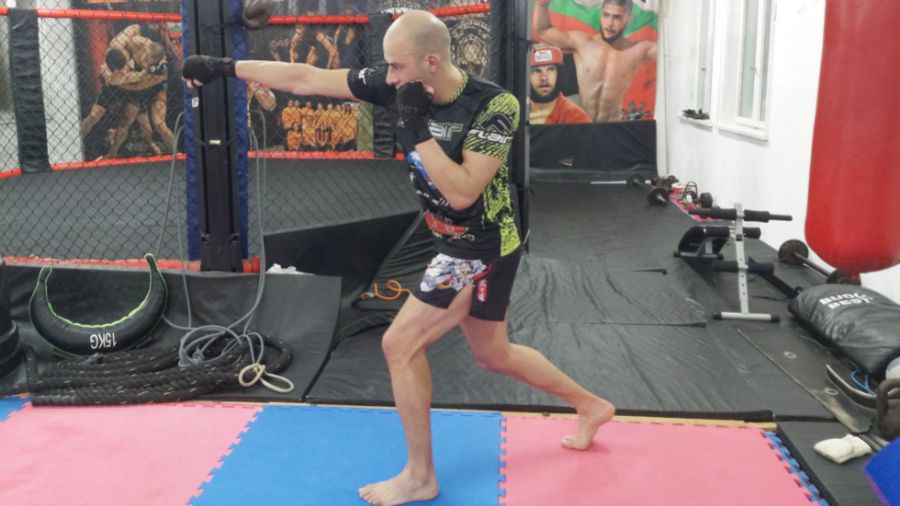
Seth Lenetsky and colleagues reference anecdotal evidence from the one and only Bruce Lee. He emphasizes the importance of relaxing the body as you strike, tensing at the last possible moment before impact.
Similarly, Jack Dempsey (a world champion boxer) states that punches should be thrown as relaxed as possible, only becoming 'frozen, steel-hard' at impact.
Both elite martial artists (without them knowing) were referring to increasing the effective mass of their strike, improving the ability to transfer momentum throughout the body to the intended target.
“If an athlete is able to relax their arm throughout a strike, and then stiffen their arm at the last possible moment, theoretically that strike would impact with greater force than one thrown with constant activation or stiffness” [4].
If an athlete were a solid uniformly block of mass (e.g., a fridge), then the calculation of punching impact force would be easy. The uniform mass would just be plugged into Newton's 2nd law above.
However, athletes are made of multiple moving segments with both rigid (bone) and soft (muscle) structures [4]. This is important as soft structures can deform at impact, coined as "wobbling mass."
"Wobbling mass" cannot transmit impact forces as effectively as a rigid mass, so your ability to punch hard is directly affected. The greater the rigidity of the impact mass (arm, trunk, and legs), the less elastic the collision is.
The less elastic the collision, the greater momentum (Momentum = Mass x Velocity) imparted on the target [4]. Take, for example, swinging two different objects at someone.
Firstly, a pool noodle is swung as hard as possible. Due to the soft mass of a pool noodle, at impact, the noodle wraps around the target, and at the point of impact, the noodle deforms slightly and creates a slight indent.
Now, take a wooden stick or bat with approximately the same mass as the noodle. When swung at the target at the same velocity as the pool noodle, the stick is rigid and can transfer more momentum to the target due to its greater effective mass. Effective mass is used to quantify the impacts of this "wobbling mass" in humans [4].
Referring to Lenetsky et al., previous research has found that increasing muscle contraction and co-contraction (opposing muscle groups both contracting simultaneously, increasing joint stability) around a given joint can reduce the deformation during impact, allowing for a greater effective mass and a more brutal punch.
You can listen to Seth talk about this in his podcast appearance below:
Additionally, the more segments involved in a movement, the greater the potential to enhance effective mass [4]. For example, stepping forward during a jab would increase the impact force compared to just throwing the arm.
At the start of the impact, two aspects of the punch need to be satisfied to transfer momentum. Firstly, all joints supporting the impact need to be stiffened (as mentioned previously) to prevent the collapse of the joint or "wobbling mass."
Secondly, it is theorized that to maximize the effectiveness of a punch, an additional force needs to be added during the time of impact [4].
The authors state that force needs to be timed carefully to coincide with the deceleration of the impact, as this is the only time force may be effectively applied.
Force applied after impact could be theorized to push at the target rather than deform it. This leads us to a critical neuromuscular phenomenon thought to cause changes in effective mass [4].
Double Peak Muscle Activation Phenomenon
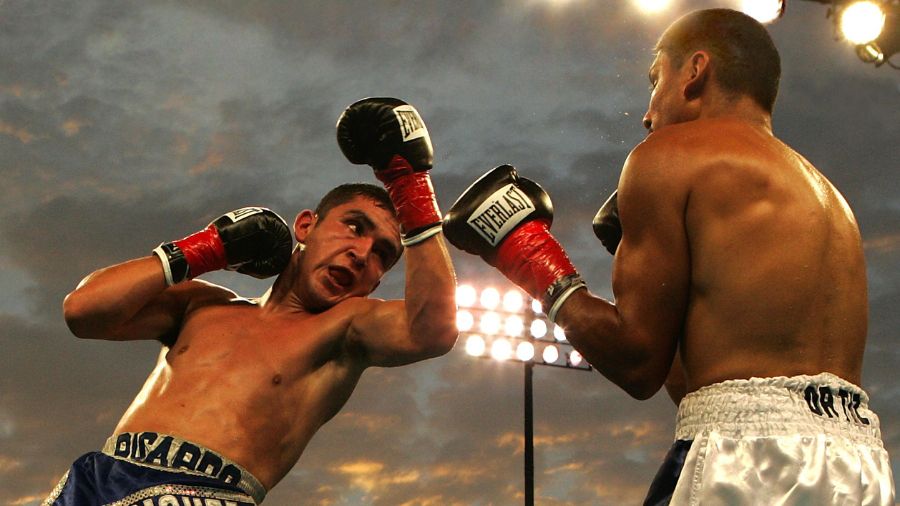
This striking technique has been found in elite mixed martial artists [9].
Double peak muscle activation refers to the involved muscle groups activating, relaxing, and then re-activating (hence the double peak).
The first peak occurs as the punch is initiated, and the relaxation period occurs throughout the movement until the second peak in activation moments before impact.
It has been claimed to occur because of the velocity needed to appropriately interact with an opponent [4].
The force-velocity relationship shows that velocity and force are inversely related; as velocity increases, the force decreases during multi-joint movements [6]. However, appropriate levels of impact force are also needed for the punch to be effective.
Hence, the double peak activation may be a way to circumvent the inherent limitations in the force-velocity relationship and result in a punch maximizing velocity and force [4].
What is interesting to note is that double peak activation occurs in trained and non-trained individuals. However, the second peak occurred much earlier for non-trained individuals and lasted much longer [4].
Therefore, non-trained individuals will intuitively stiffen the joints to brace for anticipated impact and protect the limbs. The early activation will tend to slow the velocity of the punch, thereby reducing the effective mass.
A high-level martial artist will tense at the moment of impact and continue to push through the impact to deliver a harder punch. This is believed to separate the novice from the expert [4].
What Does Data From Elite Fighters Say?
Wes Elliott from Striketec was kind enough to provide me with data and graphs from the hundreds of thousands of punch data he’s collected with his StrikeTec punch sensors.
On the Sweet Science of Fighting podcast, he states that the most significant factor for a hard punch is the initial acceleration. This is illustrated in the graph below:
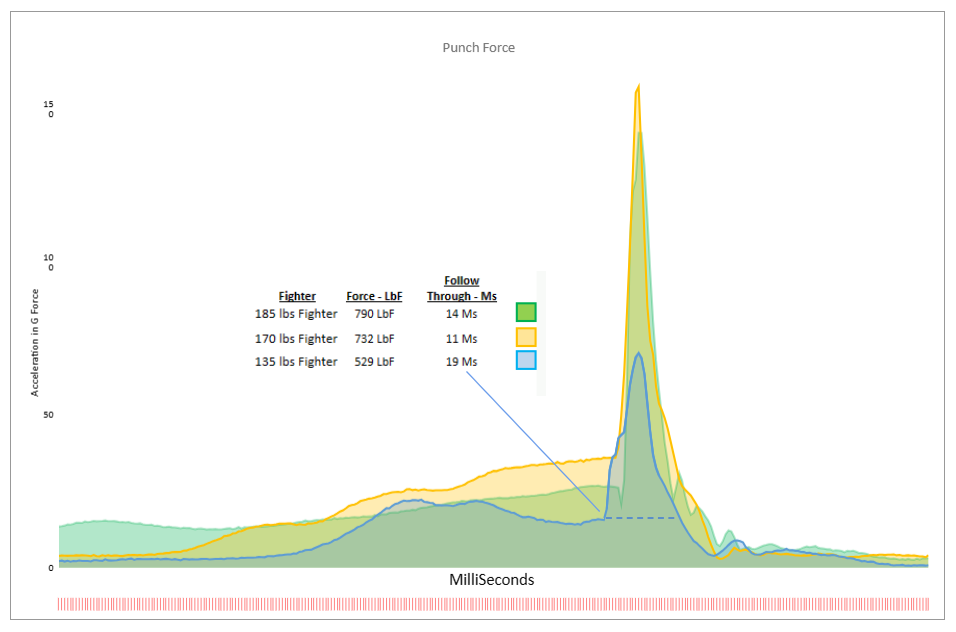
Here are the main points it illustrates from Wes:
A punch with high acceleration at impact and a solid follow-through (hitting through the bag or opponent) makes the force spike last longer, covering more area under the curve (shaded area).
This is known as impulse (force x time = mass x velocity). But if you follow through too long to increase impulse, like the blue line shows, without good acceleration at impact, the force transferred to the opponent won't be as much.
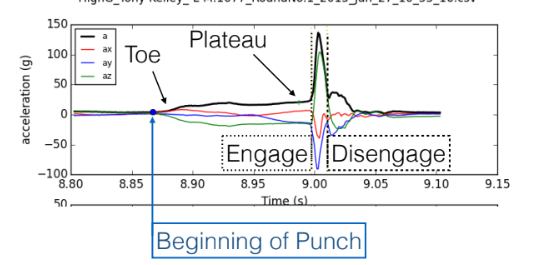
Above is another graph representing the punch. You're seeing a picture of a punch from start to finish. Here's how to make sense of it:
Engagement - The engagement point is where the punch starts getting serious. It's where the acceleration begins to ramp up.
The Plateau - Before the punch reaches its peak, there's a flat, high region on the graph called the plateau. It's like the boxer is gathering up for the big hit.
The Toe - Right before the plateau, there’s a dip on the graph known as the toe. It's where the punch is just about to rev up.
Magnitude of Acceleration - The graph shows how fast the acceleration builds up and cools down. This is the magnitude of acceleration. It goes up as the punch speeds up and comes down as the punch slows down.
Beginning of the Punch - This is where it all starts on the graph, right where the toe meets the time axis. It’s the point where the boxer begins to throw the punch.
This graph lays out the anatomy of a punch. From the moment the boxer decides to throw it, to the point of impact, and the follow-through.
By understanding these points on the graph, you get a clear picture of what’s happening with each punch thrown.
Listen to Wes explain all of this in his episode below:
How To Punch Harder & Faster
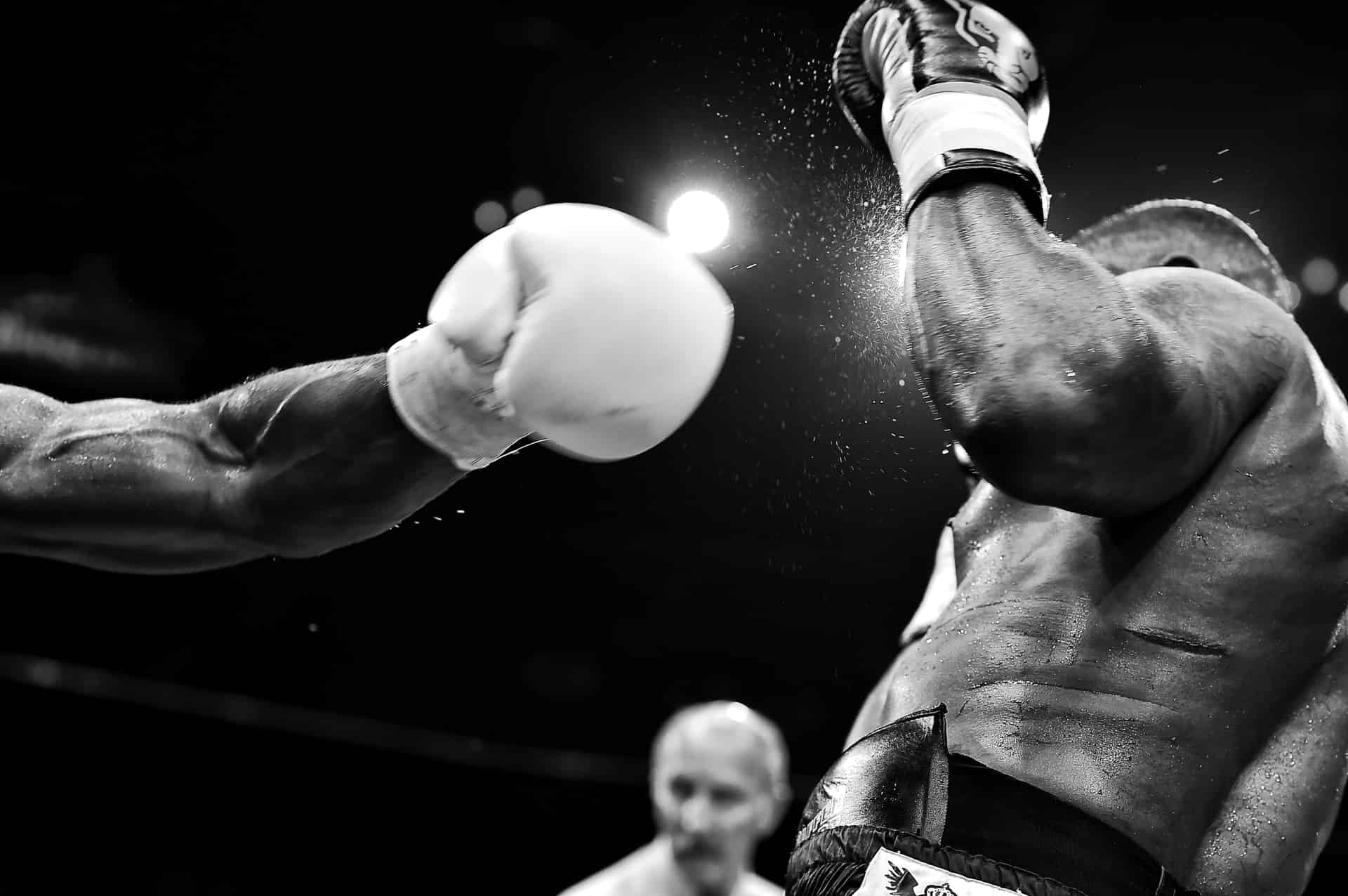
Before diving into some training applications to enhance punching power, you should note that the most significant influence on improving effective mass and, therefore, punching harder, is experience.
The more you punch a target, the better you will enhance effective mass [4].
However, using an 'energy shout' could help immediately deliver a more brutal punch.
An 'energy shout' made pre-impact of a strike can potentially increase effective mass [4]. This could be why tennis players loudly grunt whenever they strike the ball.
When training, there is evidence that choosing your combinations of strikes enhances punching velocity by 6-11% and impact forces by 5-10% [5].
When hitting pads or the heavy bag, rather than pre-determined combinations, self-select your own, and you can punch harder and faster in training, which may lead to positive long-term adaptations.
As the initial acceleration of a punch is vital, as determined from Wes Elliot's data, reactive strength is an essential physical quality. But it's more than physical qualities that enable fast initial acceleration.
It’s about anticipation, knowledge of the situation, pattern recognition, and visual scanning—all cognitive factors relating to agility.
You develop these through years of sparring. Not all-out brawls. Sparring under different constraints. It could be tempo, only being allowed to throw certain punches or smaller and bigger ring sizes.
This cognitive work, paired with the physical factors of speed and power, will develop harder punches.
Proper Technique To Punch Hard
Let's start with your stance. Your feet should be slightly wider than shoulder-width to provide you with a solid base to punch from. Your knees will be slightly bent.
As you throw your punch (in this instance, the cross or rear hand punch), your back foot will pivot toward your punch with your heel lifted off the floor.
Rotate hard and fast with your trunk while simultaneously dropping your body weight down like you are "sitting on your punch." Turn your hips in the direction of your punch with this rotation.
Keep your shoulders, arms, and hands relaxed while throwing the punch. Turn your fist over by pronating your hand while punching. You are aiming to make contact with your index and middle finger knuckles.
If you are not wearing gloves, making contact with your ring or pinky finger knuckles will likely cause them to break. Exhale sharply when you punch to take advantage of the 'energy shout.'
Common Punching Mistakes
Not Staying Grounded
To generate and transfer force effectively from the ground to your hands, you must stay on the ground when throwing a punch. This will allow you to develop the greatest effective mass.
Being Too Stiff
Just because you feel you're putting maximum effort into your punches does not mean they will be hard and fast. Stiffness will slow down your punches, as shown by the double-peak muscle activation phenomenon. Fast and loose is your ticket to a harder punch. It should feel almost effortless.
Throwing Wild Punches
Like being too stiff, throwing full-blown haymakers are slow and soft punches and leave you open to getting countered very easily.
Overreaching
Extending too far by throwing your body weight forward will only throw you off balance, not help you punch harder. You should be able to throw with power and return to your boxing stance immediately or after another punch. This is known as "sitting on your punch."
Poor Distance Control
You need to know your range. Making contact with an opponent only halfway through the punch reduces punching impact force because you cannot transfer force effectively to the target.
Punch Harder Workout
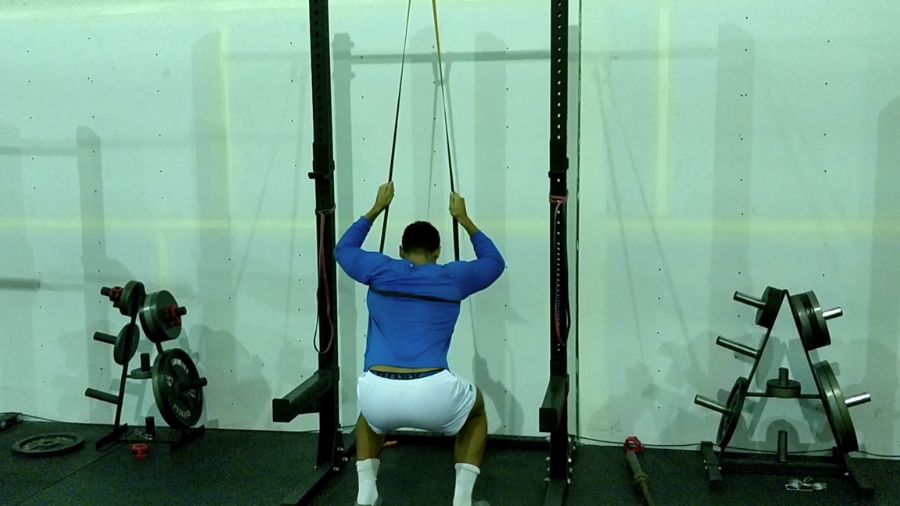
Beginner Workout For Harder Punches
Preparing for more intense work in the future. Developing a general strength base.
Day 1
Exercise | Set/Rep |
|---|---|
A1) Upper Body Extensive Med Ball Circuit | Cell |
A1) Chest Pass Wall Rebound | 1 x 15 |
A2) Sideways Rotary Pass | 1 x 15/side |
A3) Front Facing Side to Side Wall Rebound | 1 x 8/side |
A4) Slam | 1 x 15 |
B1) Box Jump | 4 x 3 |
C1) Back Squat (4 sec down) | 3 x 4 |
D1) Bench Press | 3 x 6 |
D2) Chin-Up | 3 x Max bodyweight strict |
E1) Seated Plate Rotation | 3 x 10/side |
E2) Side Plank | 3 x 30sec/side |
Day 2
Exercise | Set/Rep |
|---|---|
A1) Extensive (sub-maximal) Jumping Leg Circuit | Cell |
A1) Tuck Jump | 1 x 10 |
A2) Skater Jump | 1 x 10 |
A3) Lunge Split Jumps | 1 x 10 |
A4) Pogo Jumps | 1 x 20 |
A5) Squat Jump | 1 x 10 |
B1) Landmine Rotation | 3 x 6/side |
C1) Plate Lateral Lunge | 3 x 5/side |
D1) 1-Arm DB Press | 3 x 6 |
D2) Half-Kneeling Cable Row | 3 x 8-10/side |
Advanced Workout To Punch Harder
Day 1
Exercise | Set/Rep |
|---|---|
A1) Band Assisted Skater Rebound Jump | 3 x 3/side |
B1) Heavy Band Rotation | 3 x 5/side |
B2) Explosive Med Ball Rotational Punch Throw | 3 x 3/side |
C1) Half Squat off Pins | 3 x 2-3 |
C2) Band Assisted Jump | 3 x 5 |
D1) KB Swing | 3 x 6 |
Day 2
Exercise | Set/Rep |
|---|---|
A1) Bench Press | 3 x 1+1+1 w/30sec rest between reps @93-95% 1RM |
A2) Explosive Med Ball Chest Throw | 3 x 3 |
B2) Explosive Med Ball Rotational Punch Throw | 3 x 3/side |
A3) Bench Throw | 3 x 4 @30% 1RM |
A4) Band Assisted or Incline Clap Pushup | 3 x 5 |
B1) Weighted Pullups | 4 x 5 |
Strength Train Like A Professional Boxer & Dominate The Ring
Dominate The Ring is a 12-week program designed to rid your pillow fists and turn them into bricks!
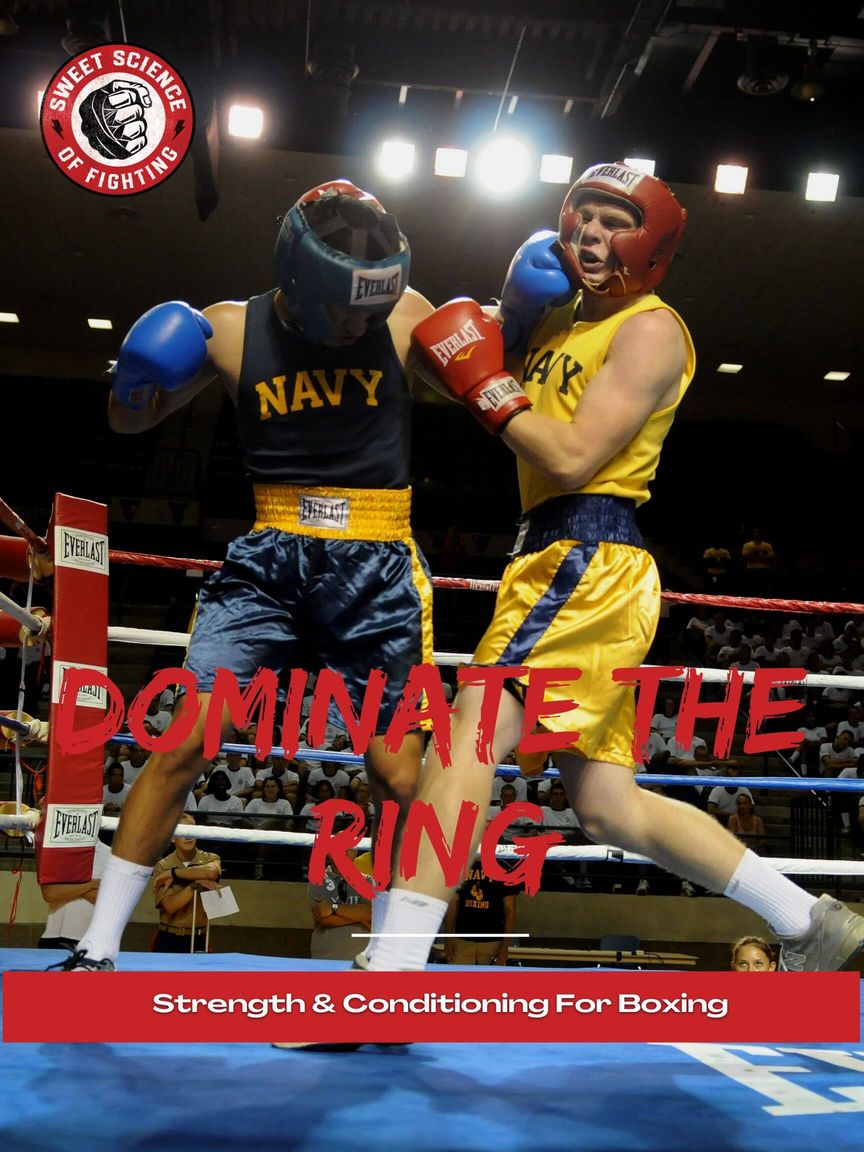

References
1. Lenetsky, Seth, Nigel Harris, and Matt Brughelli. "Assessment and contributors of punching forces in combat sports athletes: Implications for strength and conditioning." Strength & Conditioning Journal 35.2 (2013): 1-7.
2. Luturco, I., Nakamura, F, Artioli, G, Kobal, R, Kitamura, K, Cal Abad, C, Cruz, I, Romano, F, Pereira, L, & Franchini, E., Strength and power qualities are highly associated with punching impact in elite amateur boxers. Journal of Strength and Conditioning Research, 2016. 30(1): p. 109-116.
3. Filimonov VI, K.K., Husyanov ZM, & Nazarov SS., Means of increasing strength of the punch. NSCA Journal, 1985. 7: p. 65-66.
4. Lenetsky, S., Nates, R, Brughelli, M, Harris, N., Is effective mass in combat sports punching above its weight? Human Movement Science, 2015. 40: p. 89-97.
5. Halperin, I., Chapman, D. W., Martin, D. T., Lewthwaite, R., & Wulf, G. (2017). Choices enhance punching performance of competitive kickboxers. Psychological research, 81(5), 1051-1058.
6. Andersen, L. L., Andersen, J. L., Magnusson, S. P., Suetta, C., Madsen, J. L., Christensen, L. R., & Aagaard, P. (2005). Changes in the human muscle force-velocity relationship in response to resistance training and subsequent detraining. Journal of Applied Physiology, 99(1), 87-94.
7. Loturco, I., Pereira, L. A., Kobal, R., Fernandes, V., Reis, V. P., Romano, F., … & McGuigan, M. (2019). Transference Effect of Short-Term Optimum Power Load Training on the Punching Impact of Elite Boxers. Journal of strength and conditioning research.
8. Dunn, E. C., Humberstone, C. E., Franchini, E., Iredale, K. F., & Blazevich, A. J. (2022). Relationships between punch impact force and upper-and lower-body muscular strength and power in highly trained amateur boxers. Journal of strength and conditioning research, 36(4), 1019-1025.
9. McGill, S. M., Chaimberg, J. D., Frost, D. M., & Fenwick, C. M. (2010). Evidence of a double peak in muscle activation to enhance strike speed and force: an example with elite mixed martial arts fighters. The Journal of Strength & Conditioning Research, 24(2), 348-357.

